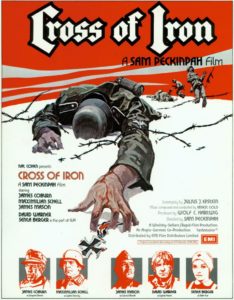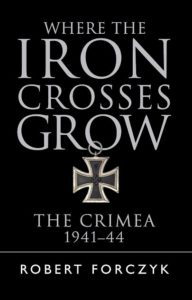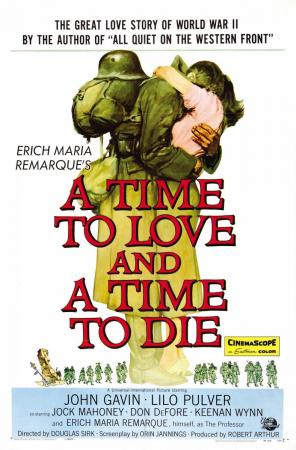ALL CLICKABLE LINKS IN RED
When Germany attacked the Soviet Union, the British and then the Americans sent material aid to the Russians. By late 1943, the effects were evident as the Soviet Army swiftly gained higher mobility thanks to the trucks supplied by the Americans.
In the spirit of cooperation, Hollywood made some morale boosting films from 1942-45 which were largely fictitious but showed that America and Russia were together in the fight against the Germans.
The picture shifted dramatically when the Cold War started in earnest from 1946. Within months of the war’s end , the spirit that was celebrated at Torgau, where Russian and American troops met (check the video link), sealing the fate of Nazi Germany, was soon gone with the wind. The Igor Gouzenko case (covered earlier in The Iron Curtain) and the Atom Bomb Spy ring symbolized aggressive Russian spying, making the “Red Scare” more appealing to Hollywood than the Eastern Front.
Despite extensive research online and offline, including consulting two encyclopaedias on War movies, I could only come up with a list that can be counted on one hand. Below is the meagre list of films that Hollywood set in the Eastern Front. The definition of “Hollywood” is to mean either it was released by a major studio or directed by a major name, or has major Hollywood actors and stars.
Cross of Iron (1977)
 Genre – War Movie (WW2)
Genre – War Movie (WW2)
Time: 2 hours 10 minutes
Platform: You Tube Free
Director : Sam Peckinpah
This is probably the ONLY mainstream movie from Hollywood that is set in the Eastern Front . For that alone it should be given a five star review. Since it’s a Sam Peckinpah film, we can assume it will be violent due to his unconventional style. And it IS brutal in showing the overall nature of the Eastern Front war.
The story is formulaic. It follows the Hollywood war-movie formula of ‘the lost patrol’. Basically, a small unit has been bypassed by the enemy and it has to fight / sneak its way back to its own lines. Except that this time the ‘own side’ are German soldiers and the ‘enemy’ are the Soviet Army/ Russians. The “lost patrol” formula may be well worn but Peckinpah gives it his all familiar hyper violent twist , including those perpetrated by and on Russian female soldiers.
Sergeant Steiner (James Coburn) is a former officer demoted to the rank of Sergeant for various infractions. His regimental commander Brandt (James Mason) trusts him. Steiner’s unit is cut off by the Russian advances of 1943 and has to reach its own position. In the meantime the HQ has a new commander Captain Stransky who has left a comfortable billet in France and has asked for and got a transfer to the Eastern Front, to earn an Iron Cross, the highest military award. (There are increasing levels for the Iron Cross as seen in this link). Stransky dislikes the insubordinate Steiner and plans with a subordinate to eliminate Steiner and his men , in his overall plan to get an Iron Cross.
The film was shot in Yugoslavia, which had tons of WW2 equipment . All the extras are soldiers from the Yugoslavian Army. The former Yugoslavia had made a nice side profit in lending its Army and equipment for war movies as it had both Western and Soviet WW2 equipment. Peckinpah, as was his habit, went on drunken binges (as the extras of the DVD reveal) and shot millions of feet of film that were finally organized. The result is a brilliant Hollywood film on the Russian Front and the brutality of war.

The last line of the film uttered by Steiner to Stransky is a classic “Come. I will show you where the Iron Crosses Grow” . You won’t believe it, but that’s the title of a book dedicated to military history. Perhaps a case of life imitating art (or art imitating art !)
Its free on You Tube . There are two links
Link 2 with Arabic hard coded subtitles
Avoid its limp stupid follow up Breakthrough (also available on You Tube) with Richard Burton as Steiner and set on the Western Front.
Real History/ Historical Background – 4 out of 5
Script – 5 out of 5
Story – 4 out of 5
Direction – 5 out of 5
Photography – 4 out of 5
Total – 4.4 out of 5
Enemy at the Gates (2001)
 This film has already been mentioned in the earlier post on films set in Stalingrad (please refer the link here). The title says it clearly : “INSPIRED by a true story” . So what are those “true events?”
This film has already been mentioned in the earlier post on films set in Stalingrad (please refer the link here). The title says it clearly : “INSPIRED by a true story” . So what are those “true events?”
- There was a big battle in Stalingrad.
- There was a real Soviet sniper named Vasily Zaitsev.
- There really really was a Russian Political commissar named Nikita Khruschev who later became the Premier.
The other things are all very creative, probably due to the writers being influenced by smoking some high-quality weed. (Alright, just kidding. It’s not THAT bad – the sniper vs sniper battles are well executed onscreen).
Real History/ Historical Background – 3 out of 5
Script – 4 out of 5
Story – 4 out of 5
Direction – 4 out of 5
Photography – 4 out of 5
Total – 3.8 out of 5
A Time to love and a Time to die (1958)

Genre – War Movie (WW2)
Time: 2 hours 22 minutes
Platform: Amazon USA (unavailable in India)
Director : Douglas Sirk
The credentials of the story writer is enough to guarantee a powerful story. The man who was a front line soldier in WW1 wrote the classic “All Quiet on the Western Front” based on his experiences. That a “German” story was made into English and appreciated too shows that the emotions and feelings in the story got through to an “English” audience.
All of Remarque’s books were banned when Hitler assumed power. Remarque became an exile and then an American citizen. He moved back to Switzerland after WW2 and wrote the book in 1954 on which the film was based. Remarque successfully conveys the essence of the film by illustrating the utter futility of war through his central character Ernst Graeber.
Its 1944 and Graeber (John Gavin) returns to Germany on leave from the Eastern Front and has already had various negative experiences. The Nazi party fanatic in their company reports a man for “defeatist sentiments” as the man had said “we are not retreating ; we are advancing toward the Fatherland”. On his leave, he sees that entire neighborhoods have been bombed out. He meets his friend Elizabeth and she tells him that her father is in a concentration camp because of some remarks about the Government. An old school friend is the head of the local Nazi Party headquarters and is living it up, savoring luxuries confiscated from “undesirables”. He visits his old professor Pohlmann (Erich Maria Remarque) who is aiding Jews to flee and who is under strict surveillance. In the middle of it all, he and Elizabeth decide to marry. Then he has to return to the fury of the Eastern Front where no quarters are given and none asked by both sides.
The film is an excellent mix of the “Home front” where every day is a matter of survival because of the continuous Allied bombing and the “Eastern Front” where the horrors are slightly different but no less a matter of survival. The sympathy is evident for the ordinary soldier who did his duty honorably and paid the ultimate price. A pall of doom and gloom runs through the movie and we are sure that its all going to end in disaster for Graeber and Elizabeth.
The film’s poor box office results can be attributed to its gloomy story, lack of major stars, despite the A grade Hollywood director who had a personal motive for taking on the project. (Though Sirk had fled to the US his family had remained behind in Germany and his son had died on the Eastern Front in 1944.)
Overall the film is superb though quite gloomy and typical of Remarque’s work in showing the futility of war
Real History/ Historical Background – 3 out of 5
Script – 4 out of 5
Story – 4 out of 5
Direction – 4 out of 5
Photography – 4 out of 5
Total – 3.8 out of 5
Defiance (2008)
Genre – War Movie (WW2) – True Story
Time: 2 hours 12 minutes
Platform: You Tube (free)
Director : Edward Zwick
Numerous “resistance movies” exist, with Western filmmakers favoring those centered around the French Resistance. Defiance is a rare Hollywood film as it talks of Russian Partisans on the Eastern front led by two brothers. The Bielski brothers. The fact that the brothers moved to the USA after WW2 probably helped in attracting Hollywood interest . Otherwise, it surely would have been still born, since the lead actor Daniel Craig had just opened his batting as James Bond in Casino Royale (2006).
Tuvia (Daniel Craig) and Zus (Liev Schreiber) Bielski are Jewish brothers who have escaped from Nazi Extermination squads and are hiding in the Belorussian forests . They soon join another bunch of Jewish refugees . They assume leadership of the group and survive by raiding farms and attacking German forces for food and supplies. They also agree with Soviet partisans to divide the activities. Hunger, sickness are bigger enemies than the Germans and every day becomes a matter of survival.
This is a great story and would have been a greater film too . Only one problem. The hero Daniel Craig looks too glamorous , clean shaven and well fed to be a starving partisan leader. The same can be said of the entire cast who look healthy . There are some goofs too like Tuvia talking about stealing penicillin from the Germans (penicillin wasn’t easily available with the Nazis while it was in widespread use by the Allies from 1943 onwards). These “Hollywood style” devices diminish the impact of what could have been an exceptional story of human resilience. Its well made but lacks punch , especially since it’s a true story and given that the Bielski brothers survived the war and lived the rest of their lives in the US.
Real History/ Historical Background – 3 out of 5
Script – 3 out of 5
Story – 4 out of 5
Direction – 4 out of 5
Photography – 4 out of 5
Total – 3.6 out of 5
Hi Rammesh,
Another excellent commentary on the subject of Hollywood and the Eastern front of World War 2 and the seeming disconnect between the two.
This is only an opinion, but perhaps Hollywood studio moguls would not see much of an American market in films on the subject of wars where U.S. involvement was not as direct as the Western front and the Pacific?
You know of the general level of ignorance of the average American, in terms of history and geography. (sorry to say that!). Straying a bit, but I doubt that the average American – after having his tax dollars expended in Afghanistan – it’s longest war, 20 years – would be able to name even two cities of that country. Or on a map, point to the location of Paktia Province (the area of largest U.S. battle with the Taliban) or even the country itself. So.. just a handful of films on even this subject, it’s most recent major war. (the recent ‘Kandahar’ made only about $ 5 million in the U.S. market).
In terms of major Hollywood films on World War 2, (taken as a whole, not just the Eastern Front), I can think of only the following films in recent years..
2017 – Dunkirk – Warner Brothers
2014 – Fury – Columbia Pictures and other studios
2009 – Inglorious Basterds – The Weinstein Company, Universal and other others
2006 – Letters From Iwo Jima – Dreamworks/Malpaso..
(I may have missed a couple.. but clearly, the interest in World War 2 seems to be fading in Hollywood).
I accept that it is an absurd analogy but this would like expecting J.P. Dutta to make a film on war in the Namibian Desert (their war of independence with South Africa), instead of his favorite tank-stomping grounds of Punjab/Rajasthan?
..
Thanks… Robin
Well said about the Indian analogy . As for US and involvement on the Eastern Front the involvement was mostly indirect ; many American planes, tanks and trucks were used by the Soviets. IN fact the Soviets LOVED the American P39 , which the USAF had more or less REJECTED favoring the heavier P47 and P51. The second most succesful ace Alexzander Pokrushkin scored many of his victories on the P39 . Just check out the episode War in the air of The Unknown War. It opens and ends with Burt Lancaster talking to Pokryshkin who describes how he used the P39 and how he literally blew away German planes.
Check out this link – the color photo is of P39s wit Red Star
https://www.rbth.com/history/336442-red-army-british-fighter-planes